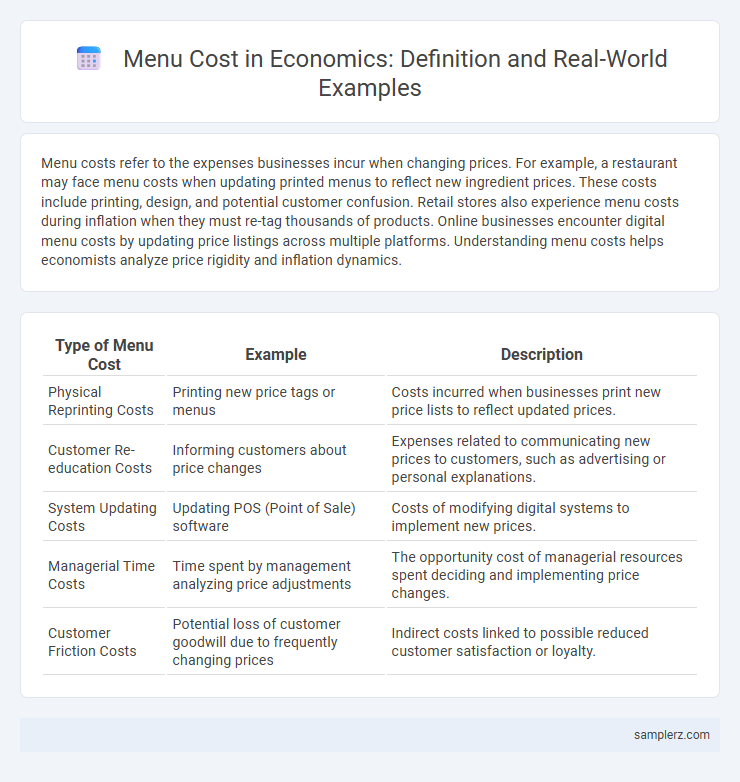Menu costs refer to the expenses businesses incur when changing prices. For example, a restaurant may face menu costs when updating printed menus to reflect new ingredient prices. These costs include printing, design, and potential customer confusion. Retail stores also experience menu costs during inflation when they must re-tag thousands of products. Online businesses encounter digital menu costs by updating price listings across multiple platforms. Understanding menu costs helps economists analyze price rigidity and inflation dynamics.
Table of Comparison
| Type of Menu Cost | Example | Description |
|---|---|---|
| Physical Reprinting Costs | Printing new price tags or menus | Costs incurred when businesses print new price lists to reflect updated prices. |
| Customer Re-education Costs | Informing customers about price changes | Expenses related to communicating new prices to customers, such as advertising or personal explanations. |
| System Updating Costs | Updating POS (Point of Sale) software | Costs of modifying digital systems to implement new prices. |
| Managerial Time Costs | Time spent by management analyzing price adjustments | The opportunity cost of managerial resources spent deciding and implementing price changes. |
| Customer Friction Costs | Potential loss of customer goodwill due to frequently changing prices | Indirect costs linked to possible reduced customer satisfaction or loyalty. |
Understanding Menu Costs in Economics
Menu costs in economics refer to the expenses businesses incur when changing prices, such as printing new menus, updating price tags, or reprogramming digital systems. For example, a restaurant may face significant costs when adjusting its menu prices due to inflation, impacting its overall profitability. These costs can lead firms to delay price changes, contributing to price stickiness in the economy.
Real-World Examples of Menu Costs
Restaurants frequently change menu prices to reflect fluctuating input costs, demonstrating classic menu costs in the economy. Retailers adjust price tags during inflationary periods to maintain profitability, incurring labor and material expenses linked to these updates. Airlines also exhibit menu costs by altering fare structures in response to fuel price volatility, impacting revenue management systems.
The Impact of Menu Costs on Business Decisions
Menu costs represent the expenses firms incur when changing prices, such as printing new menus or updating catalogs, affecting pricing strategies in retail and service industries. These costs can lead businesses to delay price adjustments despite shifts in market conditions, resulting in price stickiness and potential loss of revenue or market share. By understanding menu costs, firms optimize timing for price changes to balance adjustment expenses against competitive positioning and consumer demand fluctuations.
Menu Costs in the Digital Age
Menu costs in the digital age refer to the expenses businesses incur when updating prices on online platforms, including website adjustments and digital marketing materials. E-commerce companies face frequent changes in pricing due to dynamic algorithms and real-time data analytics, increasing the complexity and cost of menu updates. Despite lower printing costs than traditional menus, digital menu costs involve continuous software maintenance and customer experience optimization to minimize friction in price changes.
Menu Costs During Inflationary Periods
Menu costs during inflationary periods refer to the expenses businesses incur when frequently updating prices to keep up with rising costs, such as printing new menus, labels, or catalogs. High inflation forces companies to adjust prices more often, increasing operational costs and reducing profitability. These constant price revisions can also lead to inefficiencies in the market, as firms may delay adjustments, causing temporary imbalances between supply and demand.
Menu Costs and Price Stickiness
Menu costs refer to the expenses businesses incur when changing prices, such as printing new menus or updating computer systems, leading to price stickiness in the economy. This stickiness can cause firms to avoid frequent price adjustments despite changes in demand or costs, resulting in slower market responses and potential inefficiencies. For example, a restaurant might delay updating its menu prices even when supplier costs rise, maintaining outdated prices to minimize menu costs and customer confusion.
Menu Cost Examples from the Retail Sector
In the retail sector, menu costs manifest as expenses incurred when businesses update price tags, reprint catalogs, or modify digital pricing on e-commerce platforms to reflect inflation or market changes. These costs include labor, materials, and potential lost sales during the transition period. Retailers often face menu costs when adjusting prices for seasonal sales, supply chain disruptions, or competitive pricing strategies.
How Restaurants Face Menu Costs
Restaurants face menu costs when changing prices due to the expenses involved in printing new menus, retraining staff, and potential customer confusion or dissatisfaction. These costs can lead to less frequent price adjustments, impacting the restaurant's ability to respond quickly to fluctuating input costs like food supply changes. Menu costs in the restaurant industry highlight how seemingly small operational expenses contribute to price stickiness in the broader economy.
Strategies to Minimize Menu Costs in Firms
Firms minimize menu costs by adopting dynamic pricing software that automates price adjustments, reducing the need for physical reprinting of menus or catalogs. Implementing digital menus and online platforms allows rapid updates of prices with minimal expense and time, enhancing flexibility in response to market changes. Bulk updating strategies and synchronized pricing across multiple outlets further streamline the process, lowering operational costs and improving customer experience.
Menu Costs and Macroeconomic Implications
Menu costs refer to the expenses firms incur when changing prices, such as printing new menus or updating pricing systems, which can lead to price stickiness in the economy. This price rigidity affects aggregate demand and supply dynamics, potentially slowing down the adjustment to economic shocks and contributing to prolonged periods of unemployment or inflation. Understanding menu costs is crucial for macroeconomic policies aimed at stabilizing price levels and improving market efficiency.

example of menu cost in economy Infographic
 samplerz.com
samplerz.com